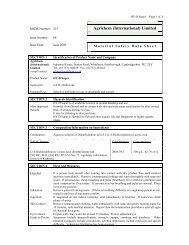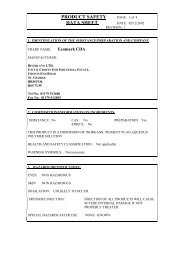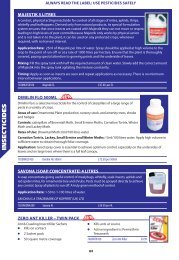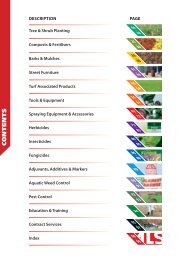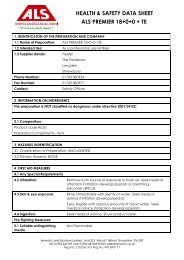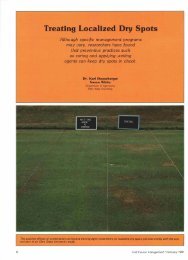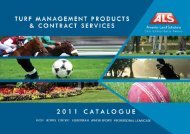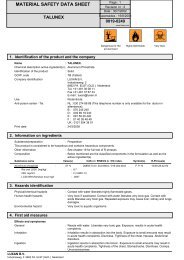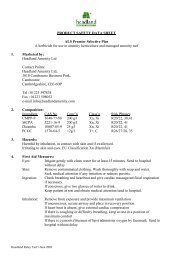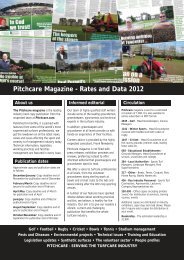these Open Championship Clubs choose to relief grind - Pitchcare
these Open Championship Clubs choose to relief grind - Pitchcare
these Open Championship Clubs choose to relief grind - Pitchcare
Create successful ePaper yourself
Turn your PDF publications into a flip-book with our unique Google optimized e-Paper software.
Golf<br />
Greg Evans<br />
Greg Evans is the current Course Manager<br />
at Ealing Golf Club. He has helped <strong>to</strong> turn<br />
around the clubs fortune from a very<br />
negative situation pre-2006 <strong>to</strong> an extremely<br />
healthy one now. Golf membership has<br />
increased steadily for the past several years<br />
and visi<strong>to</strong>r income has gone through the<br />
roof, with the past year seeing a 42%<br />
increase in revenue.<br />
To contact him please visit his website<br />
www.gregevansmg.com or by phone 07951<br />
157208.<br />
48 PC FEBRUARY/MARCH 2012<br />
Below are the criteria that I use <strong>to</strong> gauge<br />
firmness of my greens:<br />
Stand at the back of a chosen green<br />
(hopefully not becoming a target for<br />
golfers).<br />
Watch five golfers hit <strong>to</strong> the green from<br />
about 150 yards away and mark on a<br />
scale of 1-10:<br />
• 1-4 the green is very soft and the ball<br />
plugs (1 is the worst score).<br />
• 5-6 where the greens are receptive but<br />
comes out of its own pitch mark and<br />
either has forward or backspin<br />
(commonly parkland greens)<br />
• 7-8 the greens are much firmer but<br />
importantly the golfer still has control<br />
over the ball (commonly links greens).<br />
• 9-10 where the golfer cannot control<br />
the ball because the green is so hard<br />
(cricket wicket).<br />
Once you have collated the scores, you<br />
can record them in a spread sheet <strong>to</strong><br />
track your progress and <strong>to</strong> see how<br />
cultural practices, such as <strong>to</strong>pdressing<br />
and aeration, affect firmness or not. I<br />
look for a score of around 7, just a bit<br />
above a parkland feel, but not so hard<br />
that the golfer loses control of his ball.<br />
Results<br />
We can use the results <strong>to</strong> compare how we<br />
are performing from year <strong>to</strong> year. I<br />
consider the main playing season <strong>to</strong> be<br />
from early April <strong>to</strong> the end of Oc<strong>to</strong>ber.<br />
During <strong>these</strong> months your surfaces need<br />
<strong>to</strong> be performing <strong>to</strong> your own chosen<br />
targets. Above is a chart of how Ealing’s<br />
greens have performed this last playing<br />
season.<br />
By looking at the chart, we can see that<br />
the speed target for the playing season was<br />
set at 10.5. On the whole, we achieved that<br />
with an average of 10.8 for this period.<br />
Smoothness came in at 8.8 against a target<br />
figure of 8.5, with firmness just a fraction<br />
up on target at 7.1. I and, more<br />
importantly, the club are very happy with<br />
how the greens have performed during<br />
the year. Better greens performance has<br />
meant extra golf revenue this playing year.<br />
In <strong>these</strong> <strong>to</strong>ugh economic times we all<br />
have <strong>to</strong> justify our course budgets. If we<br />
are spending £5,000 sanding the greens or<br />
have spent £8,000 on a turf iron, the club<br />
wants <strong>to</strong> know what they will get out of it.<br />
By producing data on the performance of<br />
your greens, as detailed above, you will<br />
hopefully provide data <strong>to</strong> justify your<br />
expenditures with proven results.



